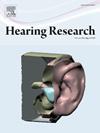眼前庭诱发肌电位记录刺激极性的定义及其意义
IF 2.5
2区 医学
Q1 AUDIOLOGY & SPEECH-LANGUAGE PATHOLOGY
引用次数: 0
摘要
目的探讨乳突刺激极性对骨传导眼前庭诱发肌生成电位(oVEMPs)记录的影响。目的是分析不同的刺激极性,特别是凝聚和稀薄,如何影响oVEMP反应的振幅和潜伏期。方法采用250 Hz和500 Hz单环正弦音脉冲刺激21例听力正常、前庭功能正常的受试者。刺激通过B250换能器以冷凝和稀薄极性传递。用人工乳突测量了输出力的波形,并计算了力的时间导数作为加速度的替代物。对于不同的刺激极性和各自的信号输出(即加速和抽搐),比较产生的oVEMP响应。结果与冷凝刺激相比,稀薄刺激通常产生更清晰、更大的n1-p1反应。在250 Hz凝露刺激下,观察到反应前n1峰,而在500 Hz凝露刺激下,在主反应后出现二次p1峰。在人工乳突上记录的输出力和震动表明,凝结阶段向内的力对引起oVEMP反应至关重要。结论刺激极性在骨传导oVEMPs的测量中起关键作用,影响反应的时间和大小,因此应经常检查和报告。对于乳突刺激,最有效的抽搐oVEMP记录是通过稀疏刺激实现的。本文章由计算机程序翻译,如有差异,请以英文原文为准。
On the definition and implications of stimulus polarity for the recording of ocular vestibular evoked myogenic potentials
Objective
This study investigates the effects of mastoid stimulus polarity on the recording of bone-conducted ocular vestibular evoked myogenic potentials (oVEMPs). The goal was to analyze how different stimulus polarities, specifically condensation and rarefaction, influence the amplitude and latency of oVEMP responses.
Methods
Monocyclic sinusoidal tone bursts at 250 Hz and 500 Hz were used to stimulate the vestibular system in 21 participants with normal hearing and normal vestibular function. The stimuli were delivered through a B250 transducer in both condensation and rarefaction polarities. The output force waveforms were measured with an artificial mastoid and the time derivative of the force were calculated as surrogate for the jerk. For the different stimulus polarities and respective signal output, i.e., acceleration and jerk, the resulting oVEMP responses were compared.
Results
Rarefaction stimuli generally produced clearer and larger n1-p1 responses compared to condensation stimuli. A pre-response n1 peak was observed for 250 Hz condensation stimulation, while 500 Hz condensation stimulation showed a secondary p1 peak following the main response. The output force and jerk, as recorded on an artificial mastoid, suggest that the inwards-directed force of the condensation phase is crucial for eliciting the oVEMP response.
Conclusion
Stimulus polarity plays a critical role in the measurement of bone-conducted oVEMPs, affecting both the timing and magnitude of the response and should thus be always checked and reported. For mastoid stimulation the most effective jerk for oVEMP recordings was achieved by rarefaction stimulation.
求助全文
通过发布文献求助,成功后即可免费获取论文全文。
去求助
来源期刊

Hearing Research
医学-耳鼻喉科学
CiteScore
5.30
自引率
14.30%
发文量
163
审稿时长
75 days
期刊介绍:
The aim of the journal is to provide a forum for papers concerned with basic peripheral and central auditory mechanisms. Emphasis is on experimental and clinical studies, but theoretical and methodological papers will also be considered. The journal publishes original research papers, review and mini- review articles, rapid communications, method/protocol and perspective articles.
Papers submitted should deal with auditory anatomy, physiology, psychophysics, imaging, modeling and behavioural studies in animals and humans, as well as hearing aids and cochlear implants. Papers dealing with the vestibular system are also considered for publication. Papers on comparative aspects of hearing and on effects of drugs and environmental contaminants on hearing function will also be considered. Clinical papers will be accepted when they contribute to the understanding of normal and pathological hearing functions.
 求助内容:
求助内容: 应助结果提醒方式:
应助结果提醒方式:


